
Karin Hills frog (Brachytarsophrys) is a genus of the family Megophryidae in the order Anura, and are found in southern China, Myanmar, northern Thailand and northern Vietnam.

The Rhacophorinae are a subfamily of frogs in the family Rhacophoridae. They range from tropical Africa and Asia to temperate China and Japan.

Theloderma, the bug-eyed frogs, mossy frogs or warty frogs, is a genus of frogs in the family Rhacophoridae, subfamily Rhacophorinae. They are found from northeastern India and southern China, through Southeast Asia, to the Greater Sunda Islands; the highest species richness is in Indochina. Some species, especially T. corticale, are sometimes kept in captivity.
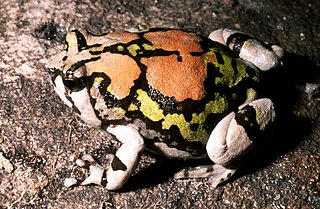
Scaphiophryne is a genus of microhylid frogs endemic to Madagascar. Some of the species are strikingly marked, while others are highly cryptic. They are rather plump and generally found on the ground. Several species in the genus are threatened because of habitat loss and overcollection for the international pet trade.
Aubria is a small genus of frogs, with two known species. All members of this genus are found in West Africa. Their common name is ball frogs or fishing frogs.

Conraua is a genus of large frogs from sub-Saharan Africa. They are sometimes known as slippery frogs. Conraua is the only genus in the family Conrauidae. Alternatively, it may be placed in the family Petropedetidae.
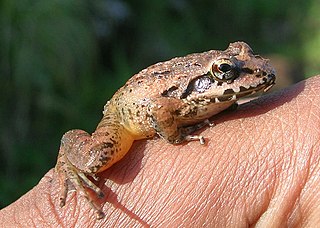
Indirana is a genus of frogs in the family Ranixalidae. These frogs are endemic to the Western Ghats of India. They are sometimes known under the common name Indian frogs, whereas members of their parent family are named "leaping frogs".

Ingerana is a genus of frogs in family Dicroglossidae. These frogs are distributed in southeastern Asia, from Nepal, northeastern India, and southwestern China to Indochina, Borneo, and the Philippines. They are sometimes known as the eastern frogs.
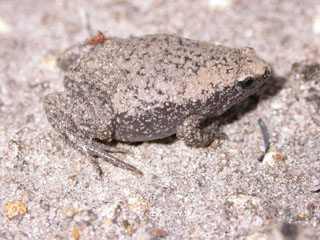
Gastrophryne, the narrowmouth toads, is a genus of microhylid frogs found in the Americas between Honduras and southern United States. Its name means ‘belly-toad’, referring to its large belly, from the Ancient Greek gastēr and phrunē.

Theloderma asperum is a frog in the family Rhacophoridae. It is also known as the pied warty frog, hill garden bug-eyed frog, or somewhat informally, bird poop frog. The frog can be found in the northeastern India, Burma, China, Thailand, Cambodia, and Vietnam as well as Sumatra in Indonesia. However, because of confusion with Theloderma albopunctatus and Theloderma baibengensis, it is known with certainty from its type locality in Peninsular Malaysia.
Nyctibates is a monotypic genus of frog in the family Arthroleptidae; its sole species is Nyctibates corrugatus. Found in Cameroon, Equatorial Guinea, and Nigeria, its natural habitats are lowland forests in hilly areas, typically forests that have humid, but not marshy, floors; it requires tall forests with closed canopy. Breeding takes place in fast, rocky streams with clean water. There are no significant threats to this species.

Nyctimantis is a genus of frogs in the family Hylidae. It is monotypic, being repredented by the single species, Nyctimantis rugiceps, commonly known as the brown-eyed treefrog. It is known from the Amazonian Ecuador, Peru, and Colombia, and it is likely to occur also in adjacent Brazil. Its natural habitats are primary and secondary lowland tropical rainforest.

Weale's running frog, Weale's frog, or rattling frog is a species of frog in the family Hyperoliidae. It is monotypic within the genus Semnodactylus. It is found in Lesotho, South Africa, and Swaziland.

Cacosternum is a genus of frog in the family Pyxicephalidae that are found in southern and eastern Africa. They have many common names, including cacos, dainty frogs, and metal frogs.

Buergeria is a genus of frogs in the family Rhacophoridae, and the sole genus of subfamily Buergeriinae. They are the sister taxon for all the other rhacophorids. This position is firmly supported by the available evidence.
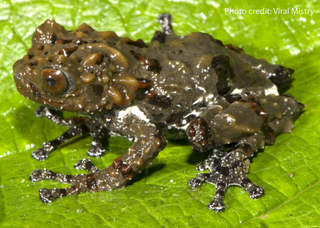
Theloderma moloch is a species of frog in the family Rhacophoridae. It is found in northeastern India and adjacent Tibet, China, possibly wider. Taxonomic placement of this taxon has been a source of much debate, possibly because of wrong tissue was used for it in a molecular study—with ramifications for the taxonomy of whole Theloderma and its sister taxon Nyctixalus.
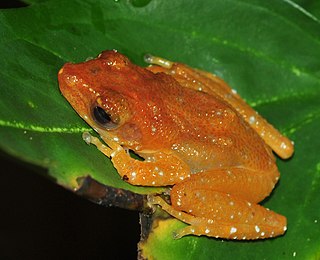
Nyctixalus pictus, also known as cinnamon frog, cinnamon treefrog, cinnamon bush frog, painted Indonesian treefrog, and white-spotted treefrog, etc., is a species of frog in the family Rhacophoridae. It is found in the Malay Peninsula, the Philippines, and parts of the Greater Sunda Islands.

The spiny tree frog is a species of frog in the family Rhacophoridae. It is endemic to the Philippines and occurs on Mindanao, Leyte, Bohol, and Basilan, possibly wider.
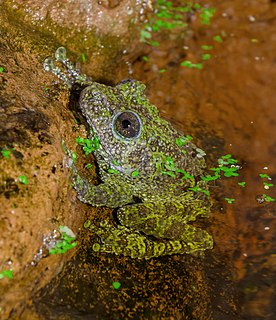
Theloderma corticale is a species of frog in the family Rhacophoridae. It is found in northern Vietnam and China, and possibly in adjacent Laos.

Ameerega is a genus of poison dart frogs in the family Dendrobatidae. These frogs live around rocks that are nearby streams. They are found in central South America north to Panama. It contains many former species of the genus Epipedobates.


















